One of the biggest products of daily life seems to be paper. It’s stacked up around my house, and it’s one of the first things to deal with when you inherit a home after someone passes away.
A Cure for Rheumatism?
My mother-in-law saved envelopes for scratch paper. My aunt repurposed them by cutting off her name and address for a kind of DIY return-address label. And, nearly 100 years ago my Grandmother Arline used an envelope to write a recipe for a home-brew cure for rheumatism. A few years ago I shared this photo and thought she had written– “Gum-go-wack, get enough for one qt. whiskey for rheumatism. one oz. 3 times a day.” Reader Marilynn commented that she thought the handwriting read “name-go-work.” I had another look, and suggest it makes more sense as something like, “Goin’ go work…” Maybe she was reminding herself to pick up some whisky on her way home from work. What do you think?
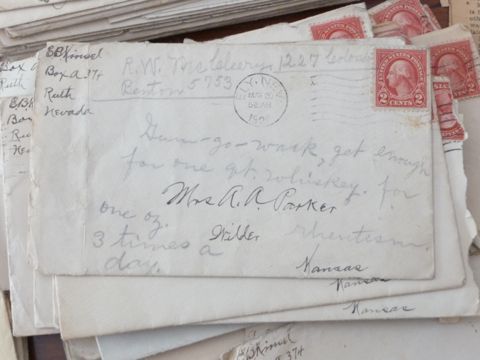
Letter from E.B. Kinsel, Ruth, Nevada to Mrs. A.A. Parker, Wilder, Kansas
The letter was sent from E.B. Kinsel, Arline’s father. I know that Eliphaz Bigelow Kinsel worked for the railroad and was rarely at home in Kansas. In 1926, my grandmother Arline was married to Charlie Parker but she must have been living either on E.B.’s farm in Wilder or on Parker’s farm.
The other address noted at the top of the envelope — R.W. McCleery of Benton is new to me. Looks like another clue to follow.
So, what exactly — as a family historian — do you do with “Found Ephemera” when you acquire a collection of papers?
Digitize, Transcribe, Preserve
Some folks would throw it away. Some might read the letter first, and then toss it. My plan includes preserving, digitizing, and extracting as much useful information as possible.
I unfold the letter, scan it and place it in an acid-free paper folder. The folders are filed by author and date in an archival vertical file box. I use the scanned image for transcribing. Any genealogical data like names, dates, events, and vital records such as neighborhood gossip are entered into my genealogy database program with the letter cited as the source of the information.
When I’m lucky, information from these bits of “found ephemera” help build a chain of evidence for a claim such a date or place of birth, marriage, or death. These tidbits are not uncommon. My ancestors lived at a distance from close family members and news traveled by letter; those letters were passed around like chocolates after dinner. They were read, re-read, and savored. Unlike the game of “Telephone” where a whispered message quickly becomes garbled and often reshaped as it makes it’s way around a circle, the news found in letters doesn’t change when the letter moves from hand to hand.
I’m looking at the photo of this envelope today and wondering what the letter inside is all about. . . or if there is a letter inside. I’m also wondering if one ounce of whiskey three times a day really does help rheumatism. . .
Finding and Using Ephemera for Genealogy
This post was first published 4 April 2013 and updated with new material on January 2017.
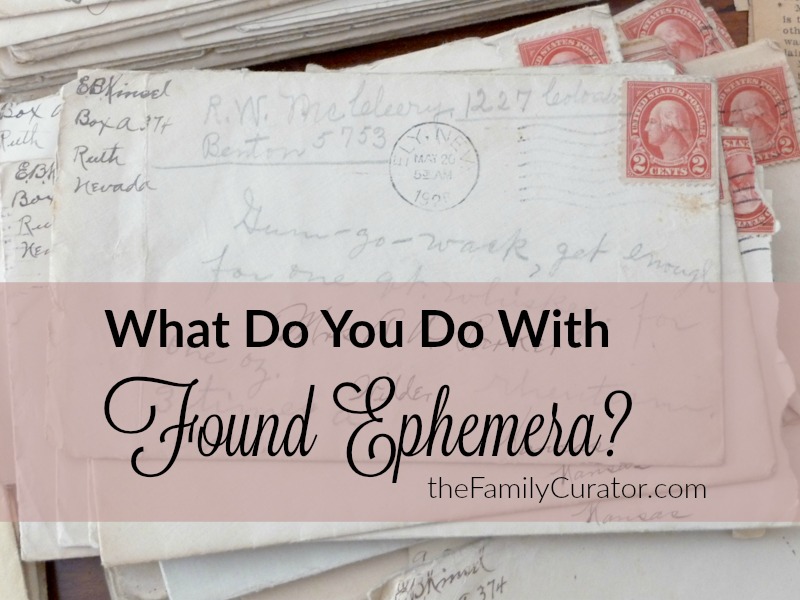
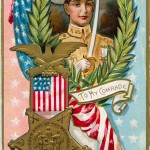
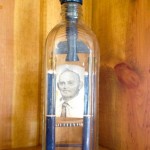
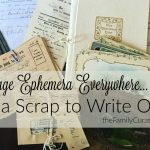



I have a collection of around 200 postcards that my grandmother saved in an album. They were sent to her by friends & family members, and some that she sent to them, in the early 1900s. It’s a wonderfull collection of vintage postcards, but even more wonderful as a source of genealogical info! I have found so many clues by studying the postmarks, return addresses, locations and dates. As you mentioned in the article, it is so enlightening to get to know my Grandma as a teenager, writing coded messages to her boyfriend (eventually my grandfather) , of whom her parents did not approve! Thanks for the advice on preservation, I want to ensure that this treasure remains intact for future generations.
I’m a fan of old postcards too. They are often overlooked but can hold wonderful information.
I think the envelope says somebody's "name-go-work" as if the person works where they sell liquor.
Hi Mariann! I think we're kindred spirits — I love reading other people's mail too! Lucky you to be the recipient of your cousin's stash. Old letters tell such wonderful stories. I do think real life can be even more interesting than fiction.
Abolutely, it's a must to save both letters and envelopes, at least to me! You learn where people wrote the letter from, what the relationship was like, and all sorts of information bits! In my 3rd cousin's huge stash of genealogy documents and photos (which he gave me to go through and archive), I found a letter written from Africa by a missionary within our family-by-marriage. I blogged about it, and I wouldn't trade that letter for anything! Thanks for your post!